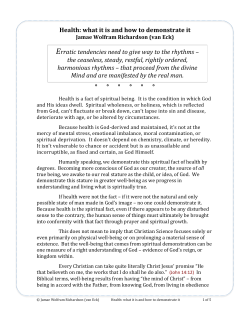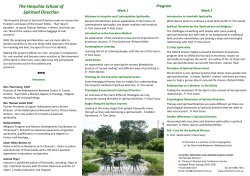
Naming and Describing Services Chaplains Provide NACC Columbus 2006
Naming and Describing Services Chaplains Provide Pre-conference Workshop March 11, 2006 NACC Columbus 2006 Rev. Dean V. Marek Mayo Clinic, Rochester, MN marek.dean@mayo.edu •© Copyright by Mayo Clinic •ALL RIGHTS RESERVED •2006 Our Published Task Attendees will develop a catalogue of pastoral/spiritual care services to describe what chaplains do. They will also author clear definitions to explain the breadth and depth of the services we provide. This catalogue may become a standard reference for certifying organizations. This is a working workshop! “Chaplains are often exhausted by the demands of their daily work, yet unable to explain exactly what they do or how they make a difference to patients or to their organizations.” Father Gerard Broccolo, Health Progress Magazine, March-April 2004. A Question What are the services that only chaplains can provide? What makes our contribution to the healthcare team unique? The Work – Part I Four published works describing chaplain services were distributed to 34 participants: 1. CARE Manual, Mayo Clinic, 1999 2. Spiritual Needs and Chaplaincy Services, Providence Health System, 2000 3. Professional Chaplaincy, Larry VandeCreek and Laurel Burton, 2001 4. Measures of Chaplain Performance and Productivity, Catholic Health Initiatives, 2002 CARE PROGRAM (Chaplain Activity Record – Electronic) USERS MANUAL Department of Chaplain Services Mayo Clinic, Rochester, MN June 10, 1999 Revised: April 26, 2001 July 16, 2004 November 12, 2004 May 31, 2005 1999 Service Types Direct AM Admit Anointing Anticipated Death Bereavement Care Conference Code 45 Crisis Care Death Ethics Consult Coordination Ethics Consult Ethics Contact Family Care Funeral/Wake Group Facilitation Home Visit Hospice Home Care Office Drop In Pastoral Contact Pre-surgical Contact Public Worship Research Intervention Retreat Care Group Ritual/Sacrament Scheduled Spiritual Assessment Spiritual Care Staff Care Staff Care Group Staff Development/Teaching Service Types Indirect Administration CPE Administration CPE Meeting CPE Preceptorship CPE Supervision CPE Teaching Meeting Mission Support Preparation Time Professional Organization Research Rounds Supervision Volunteer Coordination 2000 2001 PROFESSIONAL CHAPLAINCY Its Role and Importance In Healthcare Editors Larry VandeCreek D.Min. Laurel Burton Th.D. Design ZGroupinc NYC 2001 Chapter III 1. When religious beliefs and practices are tightly interwoven with cultural contexts, chaplains constitute a powerful reminder of the healing, sustaining, guiding, and reconciling power of religious faith. 2. Professional chaplains reach across faith group boundaries and do not proselytize. Acting on behalf of their institutions, they also seek to protect patients from being confronted by other, unwelcome, forms of spiritual intrusion. 3. They provide supportive spiritual care though empathic listening, demonstrating an understanding of persons in distress. Typical activities include: • Grief and loss care • Risk screening – identifying individuals whose religious/spiritual conflicts may compromise recovery or satisfactory adjustment • Facilitation of spiritual issues related to organ/tissue donation • Crisis intervention/Critical Incident Stress Debriefing • Spiritual assessment • Communication with caregivers • Facilitation of staff communication • Conflict resolution among staff members, patients, and family members • Referral and linkage to internal and external resources • Assistance with decision making and communication regarding decedent affairs • Staff support relative to personal crises or work stress • Institutional support during organizational change or crisis 4. Professional chaplains serve as members of patient care teams by: • Participation in medical rounds and patient care conferences, offering perspectives on the spiritual status of patients • Participation in interdisciplinary education • Charting spiritual care interventions in medical charts 5. Professional chaplains design and lead religious ceremonies of worship and ritual such as: • Prayer, meditation, and reading of holy texts • Worship and observance of holy days • Blessings and sacraments • Memorial services and funerals • Rituals at the time of birth or other significant times of life cycle transition • Holiday observances 6. Professional chaplains lead or participate in healthcare ethics programs by: • Assisting patients and families in completing advance directives • Clarifying value issues with patients, family members, staff and the organization • Participating in Ethics Committees and Institutional Review Boards • Consulting with staff and patients about ethical concerns • Pointing to human value aspects of institutional policies and behaviors • Conducting in-service education 7. Professional chaplains educate the healthcare team and community regarding the relationship o religious and spiritual issues to institutional services in the following ways: Interpreting and analyzing multi-faith and multi-cultural traditions as they impact clinical services • Making presentations concerning spirituality and health issues • Training of community religious representatives regarding the institutional procedures for effective visitation • Training and supervising volunteers from religious communities who can provide spiritual care to the sick • Conducting professional clinical education programs for seminarians, clergy, and religious leaders • Developing congregational health ministries • Educating students in the healthcare professions regarding the interface of religion and spirituality with medical care 8. Professional chaplains act as mediator and reconciler, functioning in the following ways for those who need a voice in the healthcare system: • As advocates or "cultural brokers" between institutions and patients, family members, and staff • Clarifying and interpreting institutional policies to patients, community clergy, and religious organizations • Offering patients, family members and staff an emotionally and spiritually "safe" professional from whom they can seek counsel or guidance • Representing community issues and concerns to the organization 9. Professional chaplains may serve as contact persons to arrange assessment for the appropriateness and coordination of complementary therapies. Patients increasingly demonstrate interest in healing from many sources not represented within the traditional healthcare disciplines. Many of these complementary healing traditions are grounded in the world’s religious traditions and chaplains may utilize or make a referral for complementary therapies such as: • Guided imagery/relaxation training • Meditation • Music therapy • Healing touch 10. Professional chaplains and their certifying organizations encourage and support research activities to assess the effectiveness of providing spiritual care. While many chaplains serve in settings with little interest in conducting research, others are employed by centers with a research mission. Increasingly, chaplains attend to research in the following ways: • Developing spiritual assessment and spiritual risk screening tools • Developing tools for benchmarking productivity and staffing patterns that seek to increase patient and family satisfaction • Conducting interdisciplinary research with investigators in allied fields, publishing results in medical, psychological, and chaplaincy journals • Promoting research in spiritual care at national convention 2002 Digging Deeper What are the services that only chaplains can provide? What makes our contribution to the healthcare team unique? The Work - Part I In groups of four we: 1. examined the various published descriptions of services that chaplains provide 2. eliminated generic services, i.e., those services that other non-certified, non-chaplains can provide 3. agreed on those services that are unique to chaplains 4. wrote each service type on its own post-it note (51 service were noted) 5. collated the 51 notes into 16 unique categories Generic Services There are some services that some chaplains provide that other non-chaplains could well perform, thus releasing the chaplain for those services that are sui generis to the profession. As it contained the most comprehensive listing of chaplain activities, we looked again at Professional Chaplaincy Chapter III to determine which activities were unique to chaplains, i.e., what services only chaplains could provide - • Grief and loss care • Risk screening – identifying individuals whose religious/spiritual conflicts may compromise recovery or satisfactory adjustment • Facilitate spiritual issues related to organ/tissue donation • Crisis intervention/Critical Incident Stress Debriefing • Spiritual assessment (some thought this is only the chaplain’s to do) • Communication with caregivers • Facilitate staff communication • Conflict resolution among staff members, patients, and family members • Referral and linkage to internal and external resources • Assist with decision making and communication regarding decedent affairs • Staff support relative to personal crises or work stress • Institutional support during organizational change or crisis • Participate in medical rounds and patient care conferences, offering perspectives on the spiritual status of patients • Participate in interdisciplinary education (if about religious issues) • Chart spiritual care interventions in medical charts • Assist patients and families in completing advance directives • Clarify value issues with patients, family members, staff and the organization • Participate in Ethics Committees and Institutional Review Boards • Consult with staff and patients about ethical concerns • Point to human value aspects of institutional policies and behaviors • Conduct in-service ethics education • Act as advocates or "cultural brokers" between institutions and patients, family members, and staff • Clarify and interpret institutional policies to patients, community clergy, and religious organizations • Offer patients, family members and staff an emotionally and spiritually "safe" professional from whom they can seek counsel or guidance • Represent community issues and concerns to the organization Chaplains may utilize or make a referral for complementary therapies such as: • Guided imagery/relaxation training • Meditation • Music therapy • Healing touch Chaplains attend to research in the following ways: • Developing spiritual assessment and spiritual risk screening tools • Developing tools for benchmarking productivity and staffing patterns that seek to increase patient and family satisfaction • Conducting interdisciplinary research with investigators in allied fields, publishing results in medical, psychological, and chaplaincy journals • Promoting research in spiritual care at national convention What’s Left? The following services were considered especially suited to chaplains because of an implicit or explicit reference to religion and/or spirituality and because of the specific competencies necessary to carry them out. Chapter III 2. Professional chaplains reach across faith group boundaries and do not proselytize. Acting on behalf of their institutions, they also seek to protect patients from being confronted by other, unwelcome, forms of spiritual intrusion. 5. Professional chaplains design and lead religious ceremonies of worship and ritual such as: • Prayer, meditation, and reading of holy texts • Worship and observance of holy days • Blessings and sacraments • Memorial services and funerals • Rituals at the time of birth or other significant times of life cycle transition • Holiday observances 7. Professional chaplains educate the healthcare team and community : • Interpreting and analyzing multi-faith and multi-cultural traditions as they impact clinical services • Making presentations re: spirituality and health issues • Training of community religious representatives regarding the institutional procedures for effective visitation • Training and supervising volunteers • Conducting professional clinical education programs for seminarians, clergy, and religious leaders • Developing congregational health ministries • Educating students in the healthcare professions regarding the interface of religion and spirituality with medical care The Work - Part II After lunch dyads were formed and participants were instructed to: • chose one of the 16 categories and write a clear concise description of the service • name the skills/competencies necessary to accomplish the service • separate the service provided from the skills needed to provide the service The 16 Service Types (In Alphabetical Order) The number of “hits” associated with each category represents the number of times the service was mentioned in the Part I 1. Advocacy – 1 Hit • Chaplains are a voice for the voiceless, vulnerable, and persons at risk • Editorial comment: – Advocacy may be viewed as a skill to facilitate appropriate services for patient care 2. Charting Spiritual Care – 1 Hit • Record a clear and concise summary of the patient’s spiritual concerns, how they have been addressed, and the plan of care • Communicate necessary information to the interdisciplinary team • Comment: – Charting is an institutional imperative – Bullet 2 would view it as communication for the sake of collaboration, and thus indirect service for patient care 3. Continuing Education – 3 Hits • Professional development and maintenance of credentials for ministry • Comment: – The writers wanted to see that the experience gained in ministry would also be shared with others – This, then, would be categorized under Education 4. Ethics Facilitation – 2 Hits • Promote competent ethical reflection and decision making • Comment: – May be viewed as a skill in service of the patient – May also be categorized as Spiritual Intervention 5. Education – 12 Hits • Interpretation of the interface between spirituality and health for the institution and community • Comment: – Recipients include patients, families, staff, residents, students, parish nurses, congregational health ministries, volunteers, etc. – Venues include employee orientation, CPE, continuing education, churches, Pastoral Care Week, etc. 6. End of Life Care – 1 Hit • Pastoral care at the time of loss, grave or terminal diagnosis, withdrawal of life support, fetal demise, and sudden death • Comment: – This may be categorized as Spiritual Intervention – However, EOL Care it may stand on its own as a major ministry in Hospice and because of the nature of the population we serve 7. Interpret Religious Diversity and Spiritual Practices – 1 Hit • Interpret the spiritual/religious teachings and practices of a diverse patient population as they impact an individual need • Comment: – This is a skill that may be part of a Spiritual Intervention – It is Education in that it informs staff of unfamiliar religious practices 8. Ministry of Presence – 1 Hit • Assist those served to access their spirituality as part of the healing process • Comment: – The ministry of presence may encompass a variety of skills that are invoked by the chaplain to release the spiritual power of the patient and facilitate the healing process – It is a skill set in the chaplain’s tool kit 9. Networking – 1 Hit • Connect community faith resources to particular patient spiritual needs • Comment: – Networking is a process that results in collaboration for patient care – As such it is an indirect service that facilitates a Spiritual Intervention 10. Pastoral Presence – 1 Hit • Ministry to a patient from an initial meeting with a spiritual assessment through appropriate spiritual interventions , follow-up ministry, and dismissal • Comment: – Pastoral presence, similar to the ministry of presence, encompasses a variety of spiritual interventions that are facilitated by the chaplain to release the spiritual power of the patient – It is an attitude more than a specific service 11. Prayer and Meditation – 4 Hits • Attention to the patient’s condition reflecting the concerns of the patient providing comfort and reassurance • Comment: – Prayer is often viewed as something done by the chaplain for the patient, “I’ll pray for you,” rather than a sacred/spiritual dialogue that facilitates the patient’s journey to his/her soul wherein lies the primary source of spiritual power – Prayer is a tool in the chaplain’s kit that may or may not be a part of every Spiritual Intervention 12. Religious and Moral Guidance - 1 Hit • Caring for the soul of the institution, the chaplain provides religious and moral guidance to the system, administration, employees, and medical staff • Comment: – The chaplain is a facilitator of spiritual care. This category may better be included under Spiritual Intervention 13. Rituals – 13 Hits • Celebration of symbolic acts of the community of faith, which provide meaning to the experience of illness, suffering, and loss • Comment: – The number of hits would indicate that ritual practices are a large part of the services chaplains provide – See next slide for an enumeration of services mentioned 13. Rituals – 13 Hits • • • • • • • Anointing with oil Blessings Creating situation specific rituals (2x) Leading reflections Memorial services (x2) Religious services Rituals at birth and other significant times • Sacraments • Worship services (x3) 14. Spiritual/Religious Assessment - 6 Hits • Discern and understand patients’ spiritual needs and concerns in light of their current health issues • Comment: – A chaplain’s spiritual assessment is often done informally in hospital, given the short length of stay, and informs all spiritual interventions at the point of delivery – All participants believe that the professional chaplain is most qualified to make an accurate spiritual assessment 15. Spiritual Intervention – 6 Hits • Response of the community of faith to the assessed spiritual needs and concerns of the patient to find meaning in the experience of illness and facilitate the process of spiritual healing • Comment: – It is evident that several of the services already mentioned would better fit in this category – A more suitable term than intervention might be chosen to highlight the sacred nature of our care (cura animarum – care of souls) 15. Spiritual Interventions (Care) • • • • • • • • • Crisis Care Life Review Sacred Stories Support Sp. Counsel/Direction Advocacy End of Life Care Ethics Consult Interpret Rel Diversity and Practice • Networking • Prayer/Meditation • Religious/Moral Guidance • Spiritual Assessment • Theological Reflection • Rituals Not mentioned: • Bereavement Care • Family Care • Staff Care 16. Theological Reflection Sensitivity to Diversity – 2 Hits • Facilitates a patient’s ability in bringing faith to his or her current experience • Comment: – This, too, may be a Spiritual Intervention, as the chaplain facilitates the “spiritual work” of the patient. Summary by Hits 1 Each: 1. 13 Rituals 2. 12 Education 3. 6 Spiritual Assessment 4. 6 Spiritual Intervention 5. 4 Prayer/Meditation 6. 3 Continuing Ed 7. 2 Ethics Reflection 8. 2 Theological Reflection • • • • • • • • Advocacy Charting End of Life Care Interpreting Religious Diversity Ministry of Presence Networking Pastoral Presence Religious Guidance The Chaplain’s Tool Kit What are the tools/skills that we bring with us when providing pastoral/spiritual care? Tools/Skills • • • • • • • • • • • • Non-anxious Presence Non-judgmental Acceptance Respect for Diversity Solidarity with the Vulnerable Ability to Listen Compassion Empathy Self-awareness Developed Intuition Professional Boundaries Relational/Comm Skills Comfort with Silence • • • • • • • • • • • • Gift of Time Theological Education Ability to Reflect Theologically Spiritual Knowledge Religious Knowledge Shared Spiritual Power Denominational Endorsement Pastoral Authority Prayer, Rituals, and Sacraments Discernment Self Esteem Ability to Assess Spiritually The Work - Part II • • • We also examined the NACC competencies for certification to name any that are generic The group agreed that the competencies must remain intact as the necessary heart and foundation for all chaplain services • Personal • Theological • Professional No one category could stand alone as more important than the others Charting Continuing Education Advocacy Education Theological Reflection Spiritual Intervention End of Life Care COMPETENCIES Spiritual Assessment Interpret Religious Diversity Ministry of Presence Rituals Religious Guidance Ethics Facilitation Prayer Meditation Pastoral Presence Networking The Next Step • The pre-conference workshop participants will be asked by email to review again the 16 categories and offer suggestions to further delineate (add or subtract) the services unique to chaplains The Afternoon Session • Participants were asked to name for themselves those services that were unique to a chaplain by reason of profession and competencies • Results were shared at each table • Each table agreed upon one list of services as unique to chaplains • The results will be collated and compared with the work of the pre-conference workshop and posted on www.nacc.org at a later date The Beginning
© Copyright 2025










